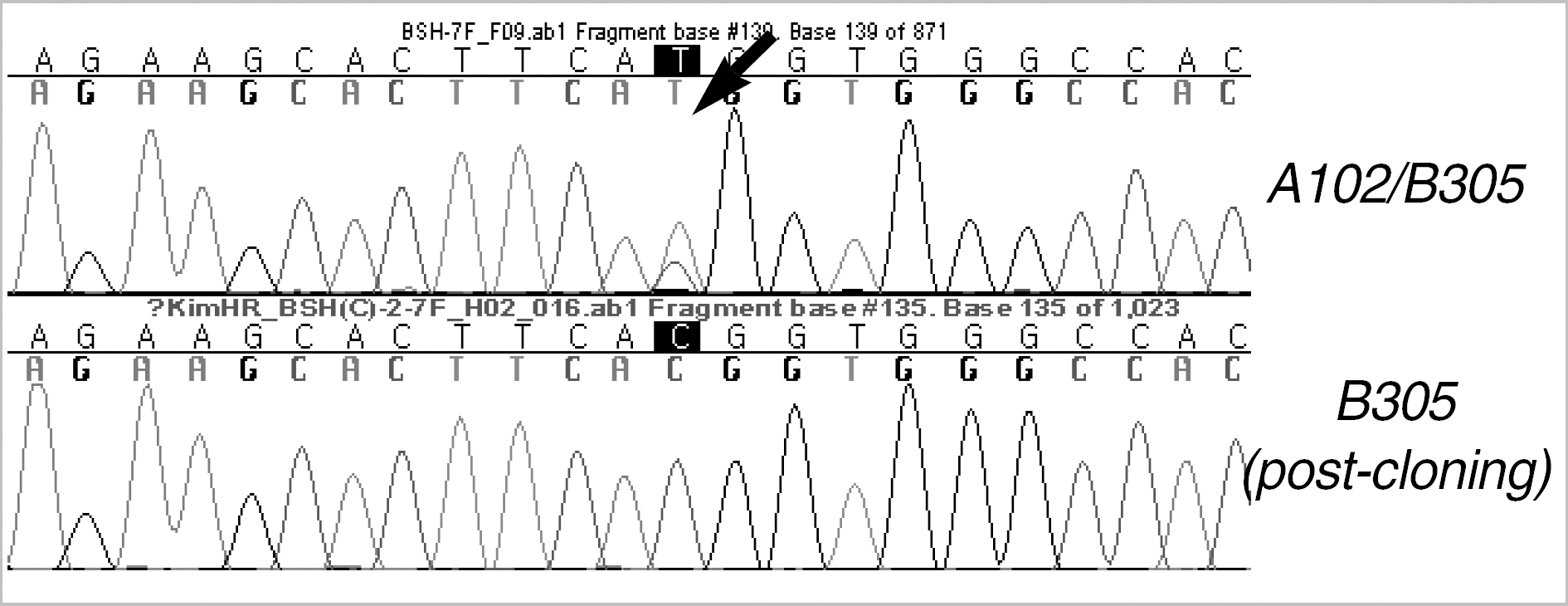Korean J Lab Med.
2010 Feb;30(1):65-69. 10.3343/kjlm.2010.30.1.65.
The M142T Mutation Causes B3 Phenotype: Three Cases and an in vitro Expression Study
- Affiliations
-
- 1Department of Laboratory Medicine1, Chonnam National University Medical School, Gwangju, Korea. dcho@chonnam.ac.kr
- 2Research Center for Cancer Immunotherapy, Chonnam National University Hwasun Hospital, Hwasun, Korea.
- 3The Institute for Transfusion Medicine and Department of Pathology, University of Pittsburgh, Pittsburgh, USA.
- 4Department of Laboratory Medicine, Eulji University School of Medicine, Daejeon, Korea.
- 5Severans Women's Clinic, Daejeon, Korea.
- KMID: 1096821
- DOI: http://doi.org/10.3343/kjlm.2010.30.1.65
Abstract
- The B3 phenotype is the most common B subtype in Korea. The B305 allele (425 T>C, M142T) was first reported in 2 Chinese individuals; however, it has not yet been reported in the Koreans, and the impact of the M142T mutation on the expression of the B3 phenotype has also not been studied. To resolve an ABO discrepancy between a group O neonate and her group O father and A(1)B(3) mother, blood samples from these individuals and other family members were referred to our laboratory for ABO gene analysis. The B305 allele was discovered in the neonate (B305/O01), her mother (A102/ B305), and her maternal aunt (B305/O02), while her father was typed as O01/O02. Transient transfection experiments were performed in HeLa cells using the B305 allele synthesized by site-directed mutagenesis; flow cytometric analysis revealed that this transfect expressed 35.5% of the total B antigen produced by the B101 allele transfect. For comparison, Bx01 allele transfects were also created, and they expressed 11.4% of the total B antigen expressed on the surface of B101 transfects. These experiments demonstrate that the M142T (425 T>C) mutation is responsible for the B subtype phenotype produced by the B305 allele.
Keyword
MeSH Terms
Figure
Reference
-
1.Yamamoto F., Clausen H., White T., Marken J., Hakomori S. Molecular genetic basis of the histo-blood group ABO system. Nature. 1990. 345:229–33.
Article2.Yamamoto F., Marken J., Tsuji T., White T., Clausen H., Hakomori S. Cloning and characterization of DNA complementary to human UDP-GalNAc: Fuc alpha 1——2Gal alpha 1——3GalNAc transferase (histo-blood group A transferase) mRNA. J Biol Chem. 1990. 265:1146–51.
Article3.Yu LC., Twu YC., Chou ML., Chang CY., Wu CY., Lin M. Molecular genetic analysis for the B(3) allele. Blood. 2002. 100:1490–2.4.Olsson ML., Irshaid NM., Hosseini-Maaf B., Hellberg A., Moulds MK., Sareneva H, et al. Genomic analysis of clinical samples with serologic ABO blood grouping discrepancies: identification of 15 novel A and B subgroup alleles. Blood. 2001. 98:1585–93.
Article5.Ogasawara K., Yabe R., Uchikawa M., Saitou N., Bannai M., Nakata K, et al. Molecular genetic analysis of variant phenotypes of the ABO blood group system. Blood. 1996. 88:2732–7.
Article6.Cho D., Kim SH., Ki CS., Choi KL., Cho YG., Song JW, et al. A novel B(var) allele (547 G>A) demonstrates differential expression depending on the co-inherited ABO allele. Vox Sang. 2004. 87:187–9.7.Seo DH., Lee CY., Kim DW., Kim SI. ABO gene analysis of cis-AB and B subgroup in blood donors. Korean J Blood Transfus. 2000. 11:27–34.8.Lee SG., Cho D., Jeon MJ., Song JW., Shin MG., Shin JH, et al. Analysis of complete exons and flanking introns of ABO gene in Korean B(3) blood donors. Korean J Blood Transfus. 2006. 17:97–105.9.Xu XG., Hong XZ., Liu Y., Zhu FM., Lv HJ., Yan LX. A novel M142T mutation in the B glycosyltransferase gene associated with B3 variant in Chinese. Zhonghua Yi Xue Yi Chuan Xue Za Zhi. 2009. 26:254–7.10.Yamamoto F., McNeill PD., Yamamoto M., Hakomori S., Harris T. Molecular genetic analysis of the ABO blood group system: 3. A(X) and B(A) alleles. Vox Sang. 1993. 64:171–4.
Article11.Ogasawara K., Yabe R., Uchikawa M., Nakata K., Watanabe J., Takahashi Y, et al. Recombination and gene conversion-like events may contribute to ABO gene diversity causing various phenotypes. Immunogenetics. 2001. 53:190–9.
Article12.Yazer MH., Blajchman MA., DiTomasso J., Denomme GA. ABO sequence analysis in a family with weak expression of blood group B. Transfusion. 2004. 44:1394–5.
Article13.Brecher ME. Technical manual. 14th ed.Bethesda: American Association of Blood Banks;2002. p. 670–1.14.Cho D., Shin MG., Yazer MH., Kee SJ., Shin JH., Suh SP, et al. The genetic and phenotypic basis of blood group A subtypes in Koreans. Transfus Med. 2005. 15:329–34.
Article15.Seltsam A., Hallensleben M., Kollmann A., Blasczyk R. The nature of diversity and diversification at the ABO locus. Blood. 2003. 102:3035–42.
Article16.Cho D., Lee JS., Park JY., Jeon MJ., Song JW., Kim SH, et al. Resolution of ABO discrepancies by ABO genotyping. Korean J Lab Med. 2006. 26:107–13.
Article17.Seltsam A., Blasczyk R. Missense mutations outside the catalytic domain of the ABO glycosyltransferase can cause weak blood group A and B phenotypes. Transfusion. 2005. 45:1663–9.
Article18.Seltsam A., Das Gupta C., Bade-Doeding C., Blasczyk R. A weak blood group A phenotype caused by a translation-initiator mutation in the ABO gene. Transfusion. 2006. 46:434–40.
Article
- Full Text Links
- Actions
-
Cited
- CITED
-
- Close
- Share
- Similar articles
-
- ABO*B3.01 Found in the A1B3 Phenotype Showing ABO Discrepancy: The First Case in Korea
- ABO Gene Analysis of Discrepant ABO Blood Group in Blood Donors
- Expression of Phospholipase C-B3 using Recombinant Baculovirus Expression System
- Effects of B3-adrenergic Receptor Gene Mutation on the Body Fat Distribution and Weight Loss in Obese Subjects
- Two AB3 and a B3 Cases from a Family




